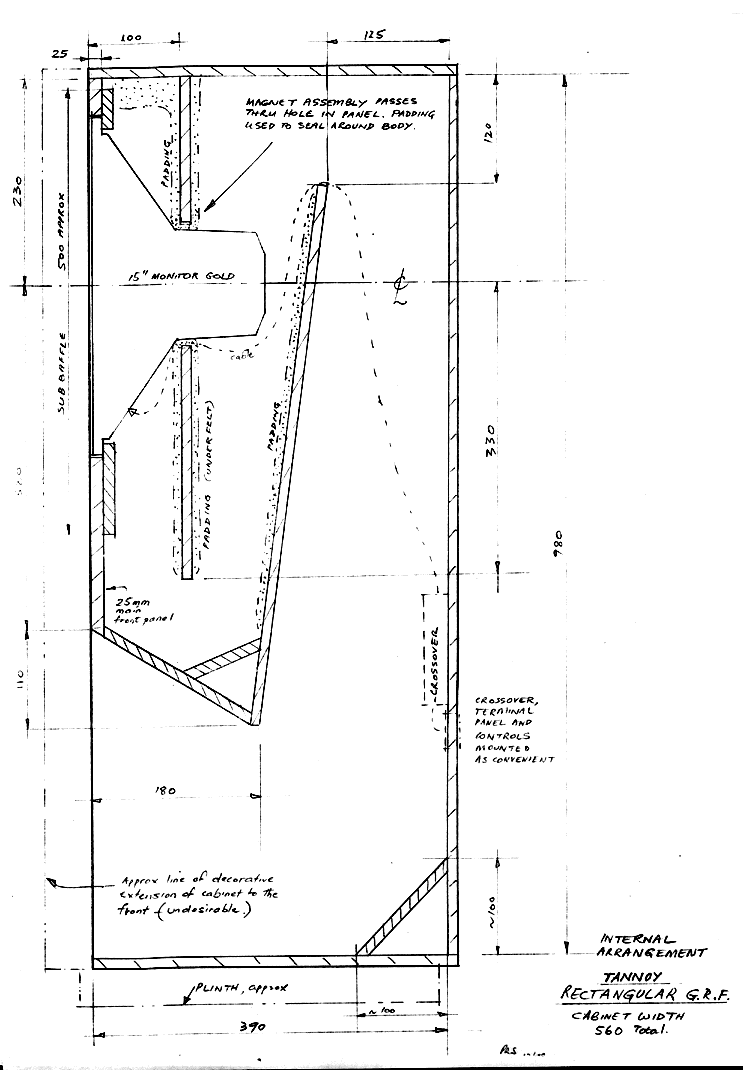I wanted to find a fairly improved cabinet design, which works in every respect superior to all the vintage designs and will be able to embed the Tannoy speaker as incomparable audio transducer. My found solution combines the open baffle principle with a sealed enclosure type, additionally a possible variable extension of its volume will give extra options of adjustments. This variable extension adapts a wide range of room preferences and customizes the best low frequency response in a given room. With its selected materials several improvements and refinements in almost all acoustical terms are audible. A more natural response is a result of the extensive use of solid coniferous wood sorts and traditional wooden connections instead of screws. The whole audio spectrum is a lot better defined with finer harmonic structures and improved tonal ability as result. Quite thin walled boards of northern plywood (15mm) are used throughout the whole design (instead of thick walled boards), instead plenty of solid strutting has been applied in combination to natural woolen felt in order to control interior reflections and resonant damping. The strutting overtakes experiences from Western Electric baffle designs to structure the boards into unregulary units in order prevent resonant additions arising. The verneer is a long fibered solid 3 mm thick mahagony wood type to add another solid wood layer. The common use of finer layered multiplex boards with loads of compound glue should be avoided, the thicker layers of the plywood have a enormous advantage in natural tonal harmony of the finished speaker.

 |
| Strutting with solid wood to structure the panels into unregular sized parts, damped with woolen felt of 13mm thickness to prevent unwanted reflections. |
 | |
|
As described already, I never could accommodate one of the classic backloaded horn designs (i.e. York, GRF, Autograph, etc.) for myself, because I don't like the always present uneven frequency (roughness) below 500 hz, arising from the not ideally formed backloaded horns. The shortening of the development, the reflections inside (turning corners), the unavoidable resonances of the huge enclosure surfaces and their much to small openings, support this effect in a amplified manner. It is always more or less effective, independent if we talk about the small GRF Rt or the biggest design the Autograph, – all these designs have a collective presence with expressive dynamics, but they are far the opposite from being a holographic transducer. The only original design I never had a chance to listen to, is the Westminster Royal. But as well here the enclosure offers infinitive foldings with huge surfaces inside, with a quite long horn development, but still far away from a ideal design. Some version have as well the "Girdacoustic" strengthened cone which is a lot to heavy, but is able to dissipate 100 watts of power. Here the given name states the foremost claim of the venture: "prestige series".
 |
| To make them sing a lot of traditional wood work is necessary... |
 |
| The crossover housing needs to be placed out of direct radiation from the speaker |
 |
| Loose assembling of some parts of the internal enclosure. |
I was convinced for all the years that the vintage 15 ohm Dual Concentic Tannoy driver is one of the best speaker designs of all time to be used with tube amplification and in a horn design enclosure. I have tried out several other duplex options from Altec, Vitavox, Stephens, Lorenz, Jensen and others without getting really involved. All the speakers I did try, have enormous potentials when well implemented, but did not attract me to be some sort of a lifetime companion. The Tannoy shows some extra qualities all the others don't match, as a result of its unique seamless integration if the hf-unit. As one of the foremost vintage enclosures I do like the Altec Voice of the Theatre A7, but unfortunatly it does not perfectly match the Tannoy preferences. Generally it can be said, all speaker designs haves beside their qualities as well some sort of disadvantages. When we decide, we are always looking to find the best compromise to our individual preferences and to our taste. Mine was and is the classic Tannoy.
My all time statement – till I had the chance to listen to a Western Electric horn array with refined tube equipment. This performance was absolutely unique, a completely different physical presentation of audio acoustics, which I had not heard before, impossible to be realized with a dual concentric speaker. The wide band medium frequency performed by one single driver unit (WE 555 with WE 15a horn, i.e. transmitted frequency from 100 to 4000 hz, with WE20 horn from 300 to 8000 hz), amplified through one ideal long horn development without compromise, is a audible class of its own, a true majestic musical instrument of highest ability.
These wide range operated horn systems are exceptional designs in a true class of their own. The WE transducer systems have been designed for cinema installations with a ultimate possible quality in mind, in a time when the later cost cutting preferences were still out of sight, which got standard in almost every case of all modern mass production in the second half of the 20th century. I will cover a complete series of articles about these speaker designs and its modern derivates made by Line Magnetics in practise for early spring time.
Read on next week for the finishing of the cabinets, Volker





No comments:
Post a Comment